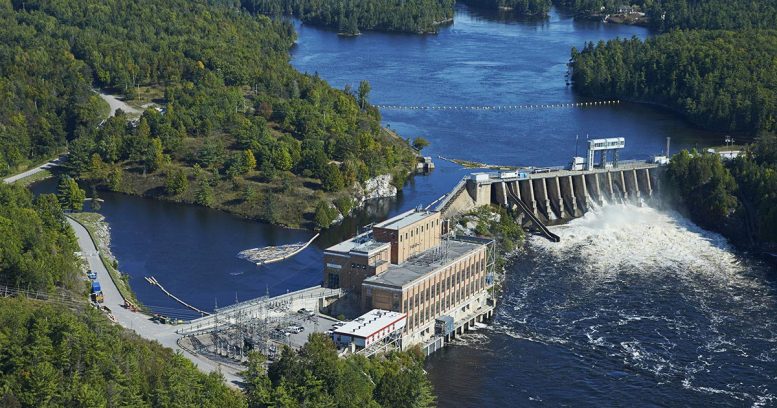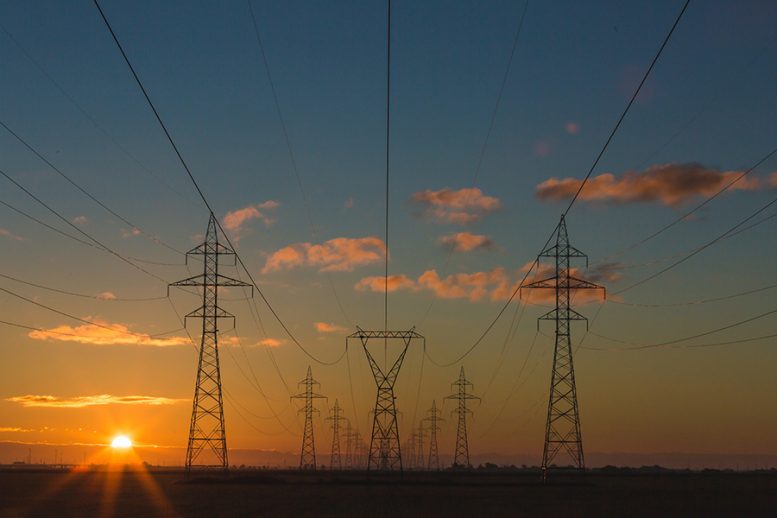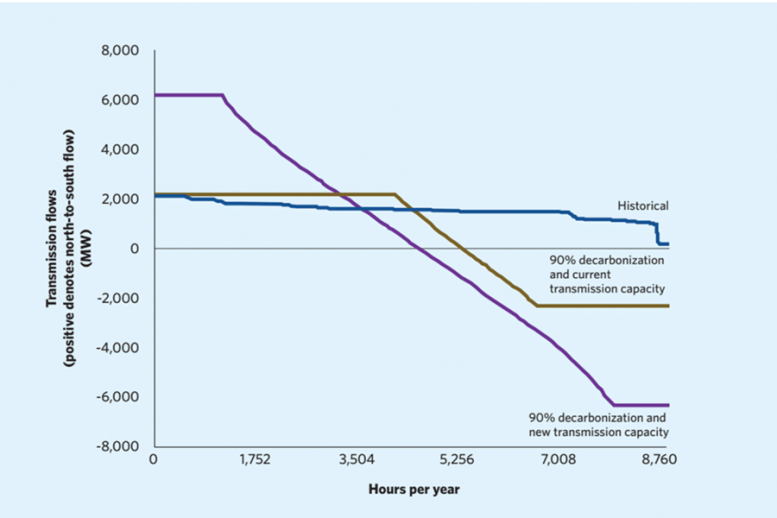
One of Hydro-Quebec’s hydroelectric generating stations. Credit: Hydro-Quebec
Power flowing both ways across the Canada–U.S. border offers a pathway to clean electricity in 2050.
The urgent need to cut carbon emissions has prompted a growing number of U.S. states to commit to achieving 100 percent clean electricity by 2040 or 2050. But figuring out how to meet those commitments and still have a reliable and affordable power system is a challenge. Wind and solar installations will form the backbone of a carbon-free power system, but what technologies can meet electricity demand when those intermittent renewable sources are not adequate?
In general, the options being discussed include nuclear power, natural gas with carbon capture and storage (CCS), and energy storage technologies such as new and improved batteries and chemical storage in the form of hydrogen. But in the northeastern United States, there is one more possibility being proposed: electricity imported from hydropower plants in the neighboring Canadian province of Quebec.
The proposition makes sense. Those plants can produce as much electricity as about 40 large nuclear power plants, and some power generated in Quebec already comes to the Northeast. So, there could be abundant additional supply to fill any shortfall when New England’s intermittent renewables underproduce. However, U.S. wind and solar investors view Canadian hydropower as a competitor and argue that reliance on foreign supply discourages further U.S. investment.
Two years ago, three researchers affiliated with the 
“Hydropower is a more-than-hundred-year-old technology, and plants are already built up north,” says Emil Dimanchev SM ’18. “We might not need to build something new. We might just need to use those plants differently or to a greater extent.” Credit: MIT
The analytical methods
To explore possible roles for Canadian hydropower to play in New England’s power system, the MIT researchers first needed to predict how the regional power system might look in 2050 — both the resources in place and how they would be operated, given any policy constraints. To perform that analysis, they used GenX, a modeling tool originally developed by Jesse Jenkins SM ’14, PhD ’18 and Nestor Sepulveda SM ’16, PhD ’20 while they were researchers at the MIT Energy Initiative (MITEI).
The GenX model is designed to support decision-making related to power system investment and real-time operation and to examine the impacts of possible policy initiatives on those decisions. Given information on current and future technologies — different kinds of power plants, energy storage technologies, and so on — GenX calculates the combination of equipment and operating conditions that can meet a defined future demand at the lowest cost. The GenX modeling tool can also incorporate specified policy constraints, such as limits on carbon emissions.
For their study, Dimanchev, Hodge, and Parsons set parameters in the GenX model using data and assumptions derived from a variety of sources to build a representation of the interconnected power systems in New England, New York, and Quebec. (They included New York to account for that state’s existing demand on the Canadian hydro resources.) For data on the available hydropower, they turned to Hydro-Québec, the public utility that owns and operates most of the hydropower plants in Quebec.
It’s standard in such analyses to include real-world engineering constraints on equipment, such as how quickly certain power plants can be ramped up and down. With help from Hydro-Québec, the researchers also put hour-to-hour operating constraints on the hydropower resource.
Most of Hydro-Québec’s plants are “reservoir hydropower” systems. In them, when power isn’t needed, the flow on a river is restrained by a dam downstream of a reservoir, and the reservoir fills up. When power is needed, the dam is opened, and the water in the reservoir runs through downstream pipes, turning turbines and generating electricity. Proper management of such a system requires adhering to certain operating constraints. For example, to prevent flooding, reservoirs must not be allowed to overfill — especially prior to spring snowmelt. And generation can’t be increased too quickly because a sudden flood of water could erode the river edges or disrupt fishing or water quality.
Based on projections from the National Renewable Energy Laboratory and elsewhere, the researchers specified electricity demand for every hour of the year 2050, and the model calculated the cost-optimal mix of technologies and system operating regime that would satisfy that hourly demand, including the dispatch of the Hydro-Québec hydropower system. In addition, the model determined how electricity would be traded among New England, New York, and Quebec.
Effects of decarbonization limits on technology mix and electricity trading
To examine the impact of the emissions-reduction mandates in the New England states, the researchers ran the model assuming reductions in carbon emissions between 80 percent and 100 percent relative to 1990 levels. The results of those runs show that, as emissions limits get more stringent, New England uses more wind and solar and extends the lifetime of its existing nuclear plants. To balance the intermittency of the renewables, the region uses natural gas plants, demand-side management, battery storage (modeled as lithium-ion batteries), and trading with Quebec’s hydropower-based system. Meanwhile, the optimal mix in Quebec is mostly composed of existing hydro generation. Some solar is added, but new reservoirs are built only if renewable costs are assumed to be very high.
The most significant — and perhaps surprising — outcome is that in all the scenarios, the hydropower-based system of Quebec is not only an exporter but also an importer of electricity, with the direction of flow on the Quebec-New England transmission lines changing over time.
Historically, energy has always flowed from Quebec to New England. The model results for 2018 show electricity flowing from north to south, with the quantity capped by the current transmission capacity limit of 2,225 megawatts (MW).
An analysis for 2050, assuming that New England decarbonizes 90 percent and the capacity of the transmission lines remains the same, finds electricity flows going both ways. Flows from north to south still dominate. But for nearly 3,500 of the 8,760 hours of the year, electricity flows in the opposite direction — from New England to Quebec. And for more than 2,200 of those hours, the flow going north is at the maximum the transmission lines can carry.
The direction of flow is motivated by economics. When renewable generation is abundant in New England, prices are low, and it’s cheaper for Quebec to import electricity from New England and conserve water in its reservoirs. Conversely, when New England’s renewables are scarce and prices are high, New England imports hydro-generated electricity from Quebec.
So rather than delivering electricity, Canadian hydro provides a means of storing the electricity generated by the intermittent renewables in New England.
“We see this in our modeling because when we tell the model to meet electricity demand using these resources, the model decides that it is cost-optimal to use the reservoirs to store energy rather than anything else,” says Dimanchev. “We should be sending the energy back and forth, so the reservoirs in Quebec are in essence a battery that we use to store some of the electricity produced by our intermittent renewables and discharge it when we need it.”
Given that outcome, the researchers decided to explore the impact of expanding the transmission capacity between New England and Quebec. Building transmission lines is always contentious, but what would be the impact if it could be done?
Their model results shows that when transmission capacity is increased from 2,225 MW to 6,225 MW, flows in both directions are greater, and in both cases the flow is at the new maximum for more than 1,000 hours.
Results of the analysis thus confirm that the economic response to expanded transmission capacity is more two-way trading. To continue the battery analogy, more transmission capacity to and from Quebec effectively increases the rate at which the battery can be charged and discharged.
Effects of two-way trading on the energy mix
What impact would the advent of two-way trading have on the mix of energy-generating sources in New England and Quebec in 2050?
Assuming current transmission capacity, in New England, the change from one-way to two-way trading increases both wind and solar power generation and to a lesser extent nuclear; it also decreases the use of natural gas with CCS. The hydro reservoirs in Canada can provide long-duration storage — over weeks, months, and even seasons — so there is less need for natural gas with CCS to cover any gaps in supply. The level of imports is slightly lower, but now there are also exports. Meanwhile, in Quebec, two-way trading reduces solar power generation, and the use of wind disappears. Exports are roughly the same, but now there are imports as well. Thus, two-way trading reallocates renewables from Quebec to New England, where it’s more economical to install and operate solar and wind systems.
Another analysis examined the impact on the energy mix of assuming two-way trading plus expanded transmission capacity. For New England, greater transmission capacity allows wind, solar, and nuclear to expand further; natural gas with CCS all but disappears; and both imports and exports increase significantly. In Quebec, solar decreases still further, and both exports and imports of electricity increase.
Those results assume that the New England power system decarbonizes by 99 percent in 2050 relative to 1990 levels. But at 90 percent and even 80 percent decarbonization levels, the model concludes that natural gas capacity decreases with the addition of new transmission relative to the current transmission scenario. Existing plants are retired, and new plants are not built as they are no longer economically justified. Since natural gas plants are the only source of carbon emissions in the 2050 energy system, the researchers conclude that the greater access to hydro reservoirs made possible by expanded transmission would accelerate the decarbonization of the electricity system.
Effects of transmission changes on costs
The researchers also explored how two-way trading with expanded transmission capacity would affect costs in New England and Quebec, assuming 99 percent decarbonization in New England. New England’s savings on fixed costs (investments in new equipment) are largely due to a decreased need to invest in more natural gas with CCS, and its savings on variable costs (operating costs) are due to a reduced need to run those plants. Quebec’s savings on fixed costs come from a reduced need to invest in solar generation. The increase in cost — borne by New England — reflects the construction and operation of the increased transmission capacity. The net benefit for the region is substantial.
Thus, the analysis shows that everyone wins as transmission capacity increases — and the benefit grows as the decarbonization target tightens. At 99 percent decarbonization, the overall New England-Quebec region pays about $21 per megawatt-hour (MWh) of electricity with today’s transmission capacity but only $18/MWh with expanded transmission. Assuming 100 percent reduction in carbon emissions, the region pays $29/MWh with current transmission capacity and only $22/MWh with expanded transmission.

This figure shows the level of electricity flow from north to south (positive numbers) and from south to north (negative numbers) versus the number of hours per year. The flows in 2018 (blue) are always from Quebec to New England and are capped by the transmission capacity limit of 2,225 megawatts. Model results for 2050 are shown in brown and purple and assume current and expanded transmission capacity, respectively. In both cases, flow is at the maximum in both directions for many hours of the year. Credit: Image courtesy of the researchers.
Addressing misconceptions
These results shed light on several misconceptions that policymakers, supporters of renewable energy, and others tend to have.
The first misconception is that the New England renewables and Canadian hydropower are competitors. The modeling results instead show that they’re complementary. When the power systems in New England and Quebec work together as an integrated system, the Canadian reservoirs are used part of the time to store the renewable electricity. And with more access to hydropower storage in Quebec, there’s generally more renewable investment in New England.
The second misconception arises when policymakers refer to Canadian hydro as a “baseload resource,” which implies a dependable source of electricity — particularly one that supplies power all the time. “Our study shows that by viewing Canadian hydropower as a baseload source of electricity — or indeed a source of electricity at all — you’re not taking full advantage of what that resource can provide,” says Dimanchev. “What we show is that Quebec’s reservoir hydro can provide storage, specifically for wind and solar. It’s a solution to the intermittency problem that we foresee in carbon-free power systems for 2050.”
While the MIT analysis focuses on New England and Quebec, the researchers believe that their results may have wider implications. As power systems in many regions expand production of renewables, the value of storage grows. Some hydropower systems have storage capacity that has not yet been fully utilized and could be a good complement to renewable generation. Taking advantage of that capacity can lower the cost of deep decarbonization and help move some regions toward a decarbonized supply of electricity.
References:
“The role of hydropower reservoirs in deep decarbonization policy” by Emil G. Dimanchev, Joshua L. Hodge and John E. Parsons, 5 May 2021, Energy Policy.DOI: 10.1016/j.enpol.2021.112369
“Two-Way Trade in Green Electrons: Deep Decarbonization of the Northeastern U.S. and the Role of Canadian Hydropower” by Emil G. Dimanchev, Joshua L. Hodge and John E. Parsons.
This research was funded by the MIT Center for Energy and Environmental Policy Research, which is supported in part by a consortium of industry and government associates.This article appears in the Autumn 2021 issue of Energy Futures, the magazine of the MIT Energy Initiative.
At the beginning, I was still puzzled. Since I read your article, I have been very impressed. It has provided a lot of innovative ideas for my thesis related to gate.io. Thank u. But I still have some doubts, can you help me? Thanks.
Thank you very much for sharing. Your article was very helpful for me to build a paper on gate.io. After reading your article, I think the idea is very good and the creative techniques are also very innovative. However, I have some different opinions, and I will continue to follow your reply.